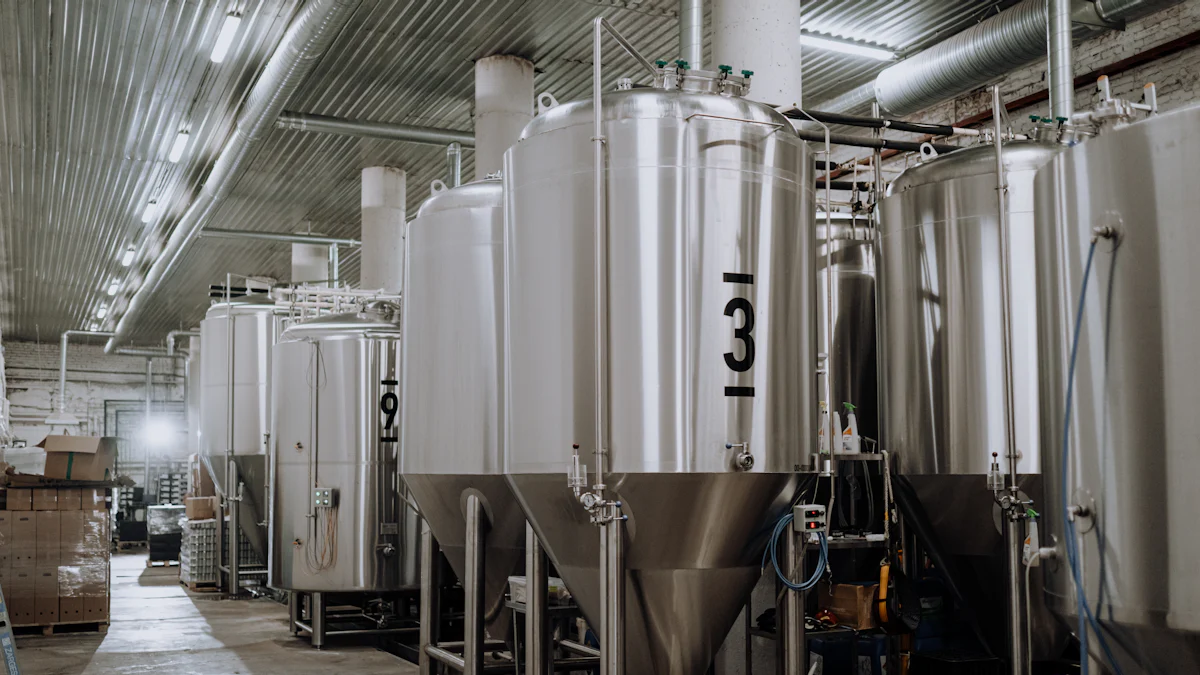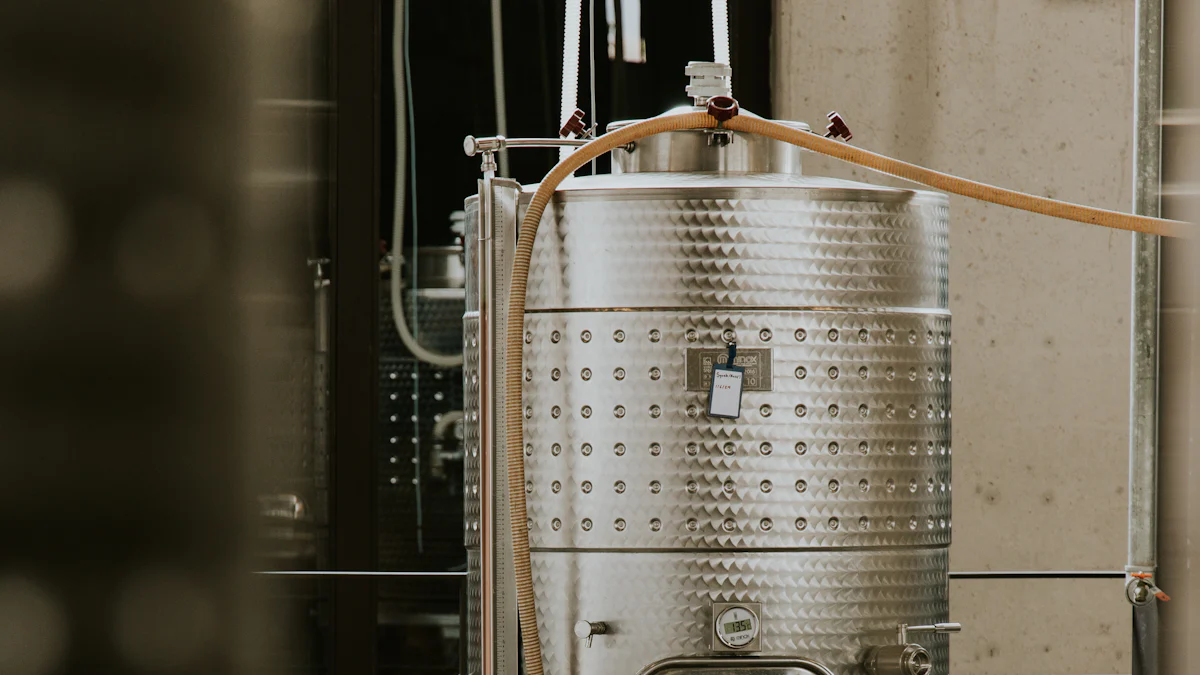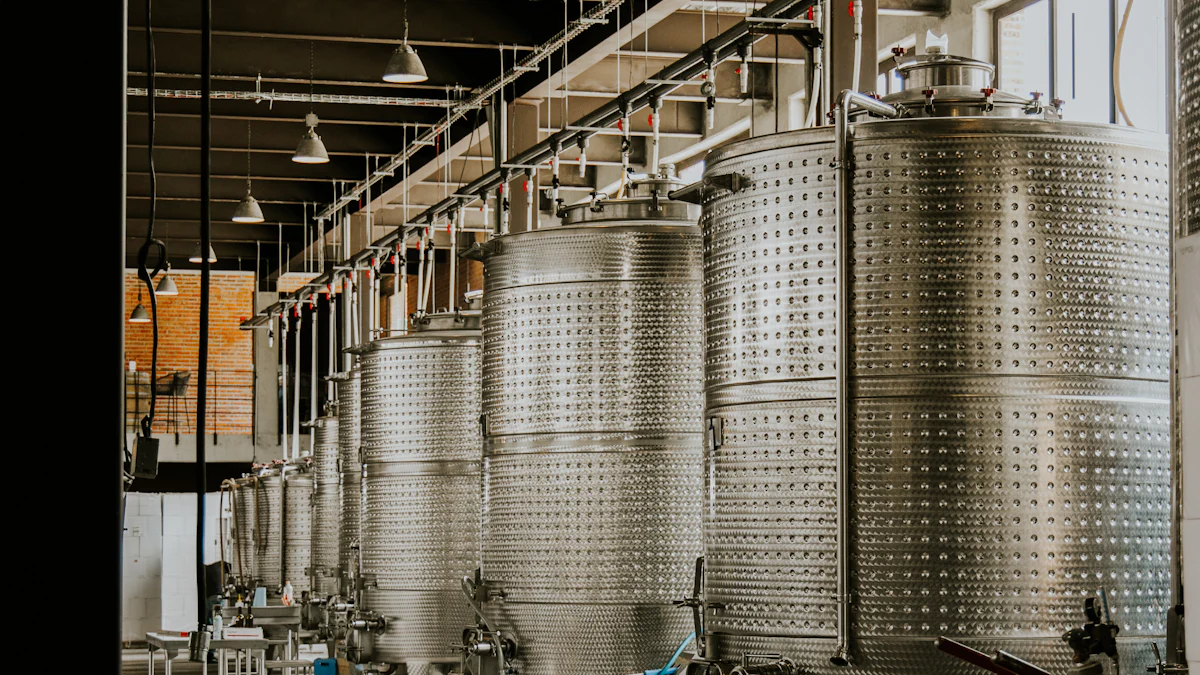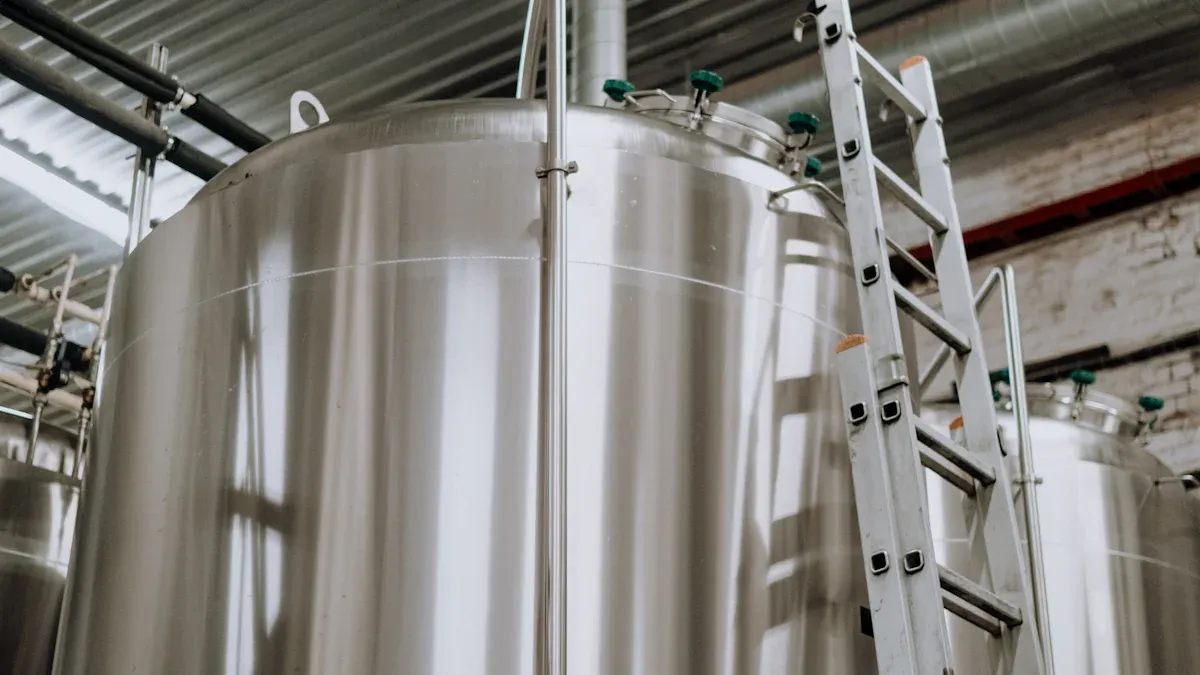
Proper maintenance of stainless steel fermentation tanks wine plays a vital role in ensuring consistent wine quality. Regular cleaning prevents residue buildup, which can lead to microbial growth and unwanted flavors. It also creates a sterile environment where yeast thrives, supporting smooth fermentation. Routine inspections help you identify worn-out seals or gaskets, reducing the risk of leaks and oxygen exposure. By keeping your tanks clean and monitoring fermentation temperatures, you protect both the equipment and the wine’s integrity. A well-maintained tank not only enhances performance but also extends the lifespan of your stainless steel brewing equipment.
Cleaning Stainless Steel Fermentation Tanks Wine

Selecting Safe Cleaning Agents
Choosing the right cleaning agents is essential to protect your stainless steel fermentation tanks wine and ensure effective cleaning. Stainless steel has a smooth surface that resists residue buildup, making it easier to clean. However, not all cleaning agents are suitable. Some can damage the tank’s surface or compromise its passivation layer.
Here’s a quick guide to common cleaning agents:
| Cleaning Agent | Effectiveness | Safety Concerns |
|---|---|---|
| Bleach | Poor choice for stainless steel | Can pit surfaces with prolonged contact |
| Caustic (Sodium Hydroxide) | Effective for organics | Dangerous, can cause severe burns |
| Phosphoric Acid | Effective for removing beer stone | Must be used with caution |
| Muriatic Acid | Neutralizes caustic effects | Excessive use can damage surfaces |
| Nitric Acid | Passivates stainless surfaces | Important to avoid damaging passivated surfaces |
For best results, use alkaline cleaners to remove grease and organic matter. Acidic cleaners work well for mineral deposits and scale. Specialized brewery cleaning agents are ideal for hops and yeast residues. Always follow the manufacturer’s instructions to avoid damage.
Effective Cleaning Techniques
A proper cleaning process ensures your tanks remain in excellent condition. Start with a preliminary rinse using high-pressure water to remove visible dirt. Next, apply a cleaning agent evenly with a brush or sponge. Allow the solution to soak for 30 minutes to an hour to break down stubborn residues.
After soaking, scrub the interior gently to dislodge any remaining debris. Rinse thoroughly with clean water to remove all traces of the cleaning agent. Finally, inspect the tank to ensure it is spotless and dry it with a clean cloth. This step prevents water spots and prepares the tank for its next use.
Preventing Residue and Biofilm Buildup
Residue and biofilm can compromise the quality of your wine. To prevent this, clean the tank immediately after each use. High-temperature water flow is particularly effective in loosening stubborn residues. Regular cleaning also reduces the adhesion of organic matter, making future cleaning easier.
Incorporate these tips for cleaning into your routine to maintain a hygienic environment. By doing so, you protect your stainless steel fermentation tanks wine from contamination and ensure consistent wine quality.
Maintaining Stainless Steel Wine Fermenter for Longevity
Inspecting and Replacing Seals
Regular inspection and timely replacement of seals are essential common maintenance practices for your stainless steel wine fermenter. Seals, gaskets, and valves can wear out over time, leading to leaks or contamination risks. You should inspect the tank components for visible damage, such as cracks or deformation. Replace any worn or damaged seals promptly to maintain a sterile environment and prevent oxygen from entering the tank.
| Best Practice | Description |
|---|---|
| Inspect Components | Check seals, gaskets, and valves for signs of wear. Replace damaged parts. |
| Proper Sealing Techniques | Ensure secure seals to minimize oxygen exposure and reduce contamination risks. |
| Regular Inspection | Conduct routine checks to identify wear and tear early. |
| Prompt Replacement | Replace faulty seals immediately to avoid leaks and maintain tank integrity. |
By following these practices, you can extend the lifespan of your stainless steel wine fermenter and ensure consistent wine quality.
Monitoring Pressure and Temperature
Monitoring pressure and temperature is another critical step in maintaining your stainless steel wine fermenter. Temperature directly affects yeast activity during fermentation. Yeast thrives within specific temperature ranges, converting sugars into alcohol while producing desirable flavors. Proper temperature control also prevents the growth of unwanted organisms, reducing spoilage risks.
- Monitor fermentation temperatures to create optimal conditions for yeast activity.
- Use cooling or heating systems to maintain the desired temperature range.
- Inspect pressure relief valves regularly to prevent tank damage caused by excessive pressure.
By keeping a close eye on these factors, you ensure smooth fermentation and protect your equipment from unnecessary strain.
Managing Oxygen Exposure
Oxygen plays a dual role in winemaking. During fermentation, it helps yeast synthesize essential fatty acids and sterols, which strengthen cell walls and reduce stress. However, excessive oxygen exposure can lead to oxidation, negatively impacting wine quality. To minimize oxygen exposure:
- Ensure tank lids or covers are tightly sealed.
- Use inert gas flushing, such as nitrogen or argon, to displace oxygen inside the tank.
These steps help you maintain the delicate balance between beneficial oxygen levels and harmful oxidation risks. Proper oxygen management preserves the integrity of your stainless steel wine fermenter and enhances wine quality.
Advanced Care for Stainless Steel Brewing Equipment
The Process and Benefits of Passivation
Passivation is a critical process that enhances the durability and performance of stainless steel brewing equipment. It involves treating the surface with an acid solution, such as nitric acid, to remove contaminants and restore the protective chromium oxide layer. This layer acts as a shield, preventing corrosion and extending the lifespan of your equipment.
Here are the key benefits of passivation:
- It improves corrosion resistance, making your equipment more durable in brewing environments.
- It simplifies cleaning and passivation processes, allowing you to save time and money.
- It ensures a hygienic surface that resists bacterial growth, reducing contamination risks during fermentation.
You should schedule passivation periodically, especially after repairs or when the equipment shows signs of wear. This proactive approach ensures your brewing tanks remain in optimal condition.
When to Use Professional Cleaning Services
Professional cleaning services can be invaluable for maintaining stainless steel brewing equipment. These services are particularly useful when dealing with stubborn residues or when establishing a clean-in-place (CIP) system.
Follow these steps to determine when professional cleaning is necessary:
- Set up a CIP process for consistent cleaning and sanitizing.
- Use CIP chemicals recommended by suppliers and monitor factors like temperature and pH.
- Apply alkaline cleaners for organic residues and acid cleaners for mineral deposits.
- Avoid abrasive tools like steel wool, which can damage the surface.
Professional services also ensure thorough cleaning and passivation, helping you maintain a clean and safe brewing environment. They use specialized techniques and equipment to handle even the most challenging cleaning tasks.
Leveraging Advanced Monitoring Tools
Advanced monitoring tools can revolutionize how you care for stainless steel brewing equipment. These tools track critical parameters like temperature, pressure, and oxygen levels in real time. By using them, you can identify potential issues early and take corrective action before they escalate.
For example, temperature sensors help you maintain the ideal conditions for fermentation. Pressure gauges protect your tanks from damage caused by excessive pressure. Oxygen monitors ensure minimal exposure, preserving the quality of your brew. Investing in these tools not only enhances cleaning and passivation efforts but also improves the overall efficiency of your brewing process.
By adopting advanced care practices, you can maximize the performance and longevity of your stainless steel brewing equipment while ensuring consistent product quality.
Safety Protocols for Maintenance
Handling Cleaning Agents Safely
Using cleaning agents safely is essential to protect both you and your stainless steel brewing equipment. Some cleaning agents can harm the tank’s surface or pose risks to your health if mishandled. Follow these safety tips to ensure proper handling:
- Avoid bleach when cleaning stainless steel. It can cause pitting and damage the tank’s surface.
- Handle caustic solutions, like sodium hydroxide, with extreme caution. These can cause severe skin burns and damage the equipment if misused.
- Use acids, such as phosphoric or muriatic acid, carefully. While effective for cleaning, improper use can harm the tank’s surface.
- Store iodophors in a dark place to maintain their effectiveness. Always follow concentration guidelines to ensure safe use.
Wear protective gear, including gloves and goggles, when working with cleaning agents. Always work in a well-ventilated area to avoid inhaling harmful fumes. By following these precautions, you can clean your tanks effectively while minimizing risks.
Adhering to Industry Standards
Adhering to industry standards ensures the safety and performance of your stainless steel brewing equipment. These standards guide the design, operation, and maintenance of fermentation tanks.
| Standard | Description |
|---|---|
| ASME | Ensures durability and compliance with industry regulations. |
| API | Provides guidelines for safe and effective tank design and operation. |
Corrosion resistance is critical due to the presence of alcohol and carbon dioxide during fermentation. Pressure resistance is equally important to handle pressure changes. Compliance with these standards ensures your tanks meet safety and quality requirements. Regular maintenance schedule adherence helps you maintain these standards over time.
Preventing Accidents During Maintenance
Preventing accidents during maintenance protects both your staff and your equipment. Proper training is the first step. Ensure your team understands best practices for cleaning and maintaining tanks.
Regular inspections of seals, gaskets, and valves help you identify wear and damage early. Following a regular maintenance schedule ensures your tanks remain in optimal condition. This approach protects your investment and ensures consistent production quality.
By implementing these safety protocols, you create a secure environment for maintenance activities. These steps also help you preserve the integrity of your stainless steel brewing equipment.
Record-Keeping for Stainless Steel Fermentation Tanks Wine
Documenting Cleaning and Maintenance Activities
Keeping detailed records of cleaning and maintenance activities ensures your stainless steel fermentation tanks remain in optimal condition. By documenting these tasks, you create a clear history of your tank’s upkeep, which helps you identify patterns and address recurring issues. For example, tracking cleaning dates ensures your tanks stay sanitary, reducing the risk of contamination. Recording repairs allows you to spot frequent problems and take proactive measures to prevent them. Additionally, noting adjustments to your equipment helps you refine fermentation processes, leading to better wine quality.
| Maintenance Activity | Benefit |
|---|---|
| Track cleaning dates | Ensures tanks are kept sanitary, preventing contamination. |
| Document repairs | Helps identify recurring issues, allowing for proactive solutions. |
| Record adjustments | Facilitates optimization of fermentation processes for better quality. |
By maintaining these records, you not only protect your equipment but also improve your overall production efficiency.
Ensuring Compliance with Regulations
Proper record-keeping plays a vital role in meeting industry regulations. Regulatory bodies often require detailed documentation to verify that your tanks are maintained according to safety and quality standards. For instance, tracking cleaning schedules demonstrates your commitment to maintaining a sanitary environment. Recording repairs and inspections shows that you address potential risks promptly. These practices ensure your tanks comply with health and safety guidelines, protecting both your business and your customers.
| Maintenance Activity | Benefit |
|---|---|
| Track cleaning dates | Demonstrates adherence to sanitation standards. |
| Document repairs | Proves proactive maintenance to regulatory bodies. |
| Record adjustments | Ensures compliance with process optimization requirements. |
By keeping accurate records, you simplify audits and inspections, ensuring your operations run smoothly.
Using Digital Tools for Record Management
Digital tools make record-keeping more efficient and reliable. Modern software allows you to store and organize data related to cleaning, repairs, and inspections. These tools often include reminders for scheduled maintenance, ensuring you never miss an important task. For example, you can use a digital platform to log cleaning activities, track repair histories, and monitor adjustments to your tanks. This approach not only saves time but also reduces the risk of human error.
Many digital tools also offer analytics features. These help you identify trends in your maintenance activities, enabling you to make informed decisions. For instance, if you notice frequent repairs in a specific area, you can address the root cause and prevent future issues. By leveraging technology, you streamline your record-keeping process and enhance the longevity of your stainless steel fermentation tanks.
Preserving Wine Quality with Stainless Steel Wine Fermenter
Avoiding Contamination Risks
Contamination can ruin the quality of your wine. Microbial contamination, for instance, occurs when bacteria, wild yeast, or molds grow inside improperly sanitized tanks. These microorganisms can cause stalled fermentations, off-flavors, and unpleasant odors. To avoid these risks, you must follow strict cleaning and sanitation protocols.
- Microbial Contamination: Leads to unwanted organisms thriving in the tank.
- Off-Flavors and Odors: Contaminants can alter the wine’s taste and aroma.
- Incomplete Fermentation: Microorganisms may disrupt the fermentation process, reducing alcohol content.
To prevent contamination:
- Clean the tank thoroughly after every use to remove residue.
- Sanitize the tank using solutions designed for winery equipment.
- Minimize oxygen exposure during fermentation to reduce oxidation risks.
By maintaining a clean and sterile environment, you protect your wine from contamination and ensure its quality remains intact.
Maintaining Consistent Fermentation Conditions
Consistent fermentation conditions are essential for producing high-quality wine. Temperature control plays a critical role in this process. Yeast activity depends on maintaining the right temperature, which helps convert sugars into alcohol and develop the wine’s flavors.
Proper sealing of your fermenter is equally important. A secure seal prevents oxygen from entering the tank, which could lead to oxidation and spoil the wine’s aroma and taste. Regularly inspect seals and gaskets to ensure they remain in good condition.
- Monitor and regulate temperature to optimize yeast performance.
- Use well-maintained seals to create a controlled fermentation environment.
- Prevent oxidation by keeping the tank tightly sealed.
By focusing on these factors, you create ideal conditions for fermentation, preserving the wine’s flavor and aroma.
Enhancing Tank Performance
Enhancing the performance of your stainless steel fermenter improves both efficiency and wine quality. Tank design plays a significant role in mixing efficiency and preventing microbial growth. Temperature control ensures optimal conditions for yeast and other microorganisms, while aeration and mixing distribute nutrients evenly.
Key strategies for boosting tank performance include:
- Tank Design: Promotes efficient mixing and reduces contamination risks.
- Temperature Control: Maintains stability for fermentation.
- Aeration and Mixing: Ensures uniform nutrient and gas distribution.
- pH Regulation: Supports microbial viability and consistency.
- Nutrient Addition: Enhances fermentation by providing essential resources.
Stainless steel tanks also offer excellent antioxidant properties, preventing oxidation that could degrade the wine. Their smooth surface makes cleaning easier, reducing residue buildup. By implementing these strategies, you maximize your tank’s potential and produce superior wine.
Common Mistakes in Maintaining Stainless Steel Brewing Equipment
Using Incorrect Cleaning Agents
Using the wrong cleaning agents can damage your stainless steel brewing equipment and compromise its performance. Bleach, for example, causes pitting corrosion when it comes into prolonged contact with stainless steel, especially in heated solutions. Caustic agents, while effective for organic residues, can lead to calcium deposits if not used carefully. Acids, though useful for removing mineral buildup, may harm the surface if applied in excessive concentrations or for too long.
To avoid these issues, always choose cleaning agents designed for stainless steel. Mild detergents or soap solutions work well for general cleaning. Non-abrasive options like baking soda paste or diluted white vinegar are safer alternatives. Never mix cleaning agents, as this can create toxic reactions that endanger both your equipment and your safety. By selecting the right products, you ensure your tanks remain clean without risking damage.
Neglecting Regular Inspections
Skipping regular inspections is a critical mistake that can lead to long-term problems. While stainless steel resists corrosion, it is not entirely corrosion-proof. Over time, wear and tear, physical damage, or discoloration may occur. Without routine checks, these issues can go unnoticed, eventually affecting the quality of your brew.
Make inspections a part of your maintenance routine. Look for signs of damage, such as scratches or cracks, which can harbor bacteria. Check for discoloration, as it may indicate corrosion. Regularly inspect seals, gaskets, and valves to ensure they remain intact. Identifying and addressing these issues early helps you maintain the integrity of your equipment and prevents costly repairs.
Overlooking Safety Protocols
Ignoring safety protocols during maintenance can result in accidents and equipment damage. Cleaning agents, for instance, can pose risks if handled improperly. Caustic solutions may cause severe burns, while mixing incompatible chemicals can release harmful fumes. Additionally, failing to use protective gear increases the likelihood of injury.
Always follow safety guidelines when maintaining your brewing equipment. Wear gloves, goggles, and other protective gear. Work in a well-ventilated area to avoid inhaling fumes. Handle cleaning agents with care, and store them properly to prevent accidents. By prioritizing safety, you protect yourself and ensure your equipment remains in top condition.
Tip: Consistently following proper maintenance practices not only extends the life of your stainless steel brewing equipment but also ensures the quality of your brew.
Benefits of Choosing High-Quality Stainless Steel Tanks

Durability and Corrosion Resistance
High-quality stainless steel tanks offer exceptional durability and corrosion resistance, making them ideal for fermentation processes. These tanks resist wear and last longer, even in demanding environments. Their corrosion resistance ensures they perform well in various conditions, including those with exposure to alcohol, carbon dioxide, or acidic substances.
| Feature | Description |
|---|---|
| Corrosion Resistance | Protects against rust and degradation in most environments. |
| Molybdenum Content | Enhances resistance to harsh conditions like chlorides and acidic environments. |
| Longevity | Extends the lifespan of the tank, reducing replacement costs. |
| Wear Resistance | Withstands physical stress, ensuring reliable performance over time. |
These features ensure your tanks maintain their structural integrity, preserving the quality of your wine or other fermented products. By investing in durable tanks, you reduce maintenance needs and improve long-term efficiency.
Customization for Specific Needs
Stainless steel tanks can be customized to meet your unique fermentation requirements. You can choose from various features to optimize performance and adapt to specific processes.
| Feature | Description |
|---|---|
| Material Grade | Options like 304 or 316 stainless steel provide varying levels of corrosion resistance. |
| Port Configuration | Allows precise placement of temperature probes and sampling ports. |
| Finishing Touches | Polished interiors simplify cleaning; exterior finishes enhance aesthetics. |
| Sloped or Conical Bottom | Facilitates easy separation of solids from liquids. |
| Sight Glasses | Enables monitoring of liquid levels without opening the tank. |
| Sampling Valves | Allows testing during fermentation without disrupting the process. |
You can also select tank designs tailored to your production style. For example:
- Open-top tanks allow CO2 to escape, ideal for red wine fermentation.
- Closed-top tanks minimize oxygen exposure, perfect for white wines.
- Variable-capacity tanks adjust to different batch sizes, offering flexibility for small wineries.
These options ensure your tanks align with your production goals, enhancing both efficiency and product quality.
Certifications and Quality Standards
When selecting stainless steel tanks, certifications and quality standards play a crucial role in ensuring safety and performance. Tanks manufactured according to recognized standards meet strict guidelines for durability, corrosion resistance, and pressure handling.
Look for certifications such as:
- American Society of Mechanical Engineers (ASME)
- UL 142 certifications
These certifications demonstrate that the tanks comply with industry regulations and undergo rigorous quality control processes. By choosing certified tanks, you ensure they meet or exceed safety and performance expectations, giving you peace of mind during fermentation.
Maintaining stainless steel fermentation tanks wine requires consistent effort and attention to detail. Regular cleaning removes residues that could compromise wine quality, while inspecting seals and monitoring temperature ensures optimal fermentation conditions. By adopting advanced care practices like passivation and leveraging digital tools for record-keeping, you can extend the lifespan of your stainless steel brewing equipment. These steps not only preserve the natural flavors of your wine but also enhance the efficiency of your operations. Commit to these practices today to achieve long-term success in 2025 and beyond.
FAQ
What is the best way to clean stainless steel fermentation tanks?
Use alkaline cleaners for organic residues and acidic cleaners for mineral deposits. Rinse thoroughly with high-pressure water after cleaning. Avoid abrasive tools like steel wool. Follow the cleaning agent manufacturer’s instructions to protect the tank’s surface and ensure effective sanitation.
How often should you inspect stainless steel wine fermenters?
Inspect your fermenters after every use. Check seals, gaskets, and valves for wear or damage. Look for scratches, cracks, or discoloration on the tank’s surface. Regular inspections help you identify issues early and maintain optimal performance.
Can you use bleach to clean stainless steel brewing equipment?
Avoid using bleach. It can cause pitting corrosion and damage the tank’s surface. Instead, choose cleaning agents specifically designed for stainless steel. These options ensure effective cleaning without compromising the equipment’s integrity.
Why is passivation important for stainless steel tanks?
Passivation restores the protective chromium oxide layer on stainless steel. This process enhances corrosion resistance, simplifies cleaning, and reduces contamination risks. Schedule passivation periodically, especially after repairs or when signs of wear appear, to extend your tank’s lifespan.
What tools can help you monitor fermentation conditions?
Use temperature sensors, pressure gauges, and oxygen monitors. These tools track critical parameters in real time, ensuring optimal fermentation conditions. Advanced monitoring systems also alert you to potential issues, helping you take corrective action quickly.



